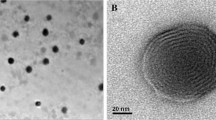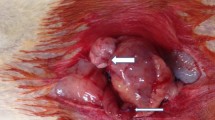Abstract
In this study, we assessed the effects of halofuginone and methylprednisolone on hypopharyngeal and esophageal stricture that can develop following radiation to the head and neck of rats. Rats were divided into four groups randomly and 18 Gy radiation was given to the head and neck regions of all rats except the control group. Group 1 (Control Group): No radiation or drugs were administered. Group 2 (Radiation Group): only radiation was applied without any drugs. Group 3 (Halofuginone Group): halofuginone 100 μg/kg per day was given intraperitoneally. Group 4 (Methylprednisolone Group): methylprednisolone 1 mg/kg per day was administered intramuscularly. In all groups, 90 days after application of radiation, sections of the proximal esophagus and hypopharynx were examined for fibrosis, fibroblast proliferation, vascularization, epithelial atypia, necrosis, polymorphonuclear leukocytes, mononuclear cells, and stenosis index by light microscope and the hydroxyproline levels were assessed biochemically. Fibrosis, epithelial atypia and hydroxyproline levels were found to be significantly higher in the radiation group compared to the control group (P < 0.05). We did not observe fibrosis in either the halofuginone or the control groups. Fibrosis was also significantly lower in the methylprednisolone group than the radiation group (P < 0.05). The differences of the stenosis index scores between the groups were not statistically significant (P < 0.05). Vascularization was similar in all groups. We think that especially halofuginone is a drug that can be used safely to prevent fibrosis due to radiotherapy, but further studies are needed.



Similar content being viewed by others
References
Cooper JS, Fu K, Marks J, Silverman S (1995) Late effects of radiation therapy in the head and neck region. Int J Radiat Oncol Biol Phys 31:1141–1164
Nagler RM, Baum BJ, Miller G, Fox PC (1998) Long-term salivary effects of single-dose head and neck irradiation in the rat. Arch Oral Biol 43:297–303
Alper T, Cramp WA (1989) The role of repair in radiobiology. Experientia 45:21–33
Roswit B, Malsky SJ, Reid CB (1972) Severe radiation injuries of the stomach, small intestine, colon and rectum. Am J Roentgenol Radium Ther Nucl Med 114:460–475
Goldstein HM, Rogers LF, Fletcher GH, Dodd GD (1975) Radiological manifestations of radiation-induced injury to the normal upper gastrointestinal tract. Radiology 117:135–140
Dent P, Yacoub A, Contessa J, Caron R, Amorino G, Valerie K et al (2003) Stress and radiation-induced activation of multiple intracellular signaling pathways. Radiat Res 159:283–300
Xavier S, Piek E, Fujii M, Javelaud D, Mauviel A, Flanders KC et al (2004) Amelioration of radiation-induced fibrosis: inhibition of transforming growth factor-beta signaling by halofuginone. J Biol Chem 279:15167–15176
Pines M, Nagler A (1998) Halofuginone: a novel antifibrotic therapy. Gen Pharmacol 30:445–450
Bautista A, Tojo R, Varela R, Estevez E, Villanueva A, Cadranel S (1996) Effects of prednisolone and dexamethasone on alkali burns of the esophagus in rabbit. J Pediatr Gastroenterol Nutr 22:275–283
Mazigh Mrad S, Boukthir S, Sfaihi L, Fetni I, Dabbabi A, Zouari B, Barsaoui S (2004) Therapeutic management and clinical course of severe caustic oesophageal burns in children treated with methyl-prednisolone. Experience at a digestive endoscopic unit. Tunis Med 82:951–957
Mosier HD Jr, Jansons RA (1967) Stunted growth in rats following X-irradiation of the head. Growth 31:139–148
Lepke RA, Libshitz HI (1983) Radiation-induced injury of the esophagus. Radiology 148:375–378
Laurell G, Kraepelien T, Mavroidis P, Lind BK, Fernberg JO, Beckman M, Lind MG (2003) Stricture of the proximal esophagus in head and neck carcinoma patients after radiotherapy. Cancer 97:1693–1700
Chabora BM, Hopfan S, Wittes R (1977) Esophageal complications in the treatment of oat cell carcinoma with combined irradiation and chemotherapy. Radiology 123:185–187
Nagler RM (2001) Extended-term effects of head and neck irradiation in a rodent. Eur J Cancer 37:1938–1945
Mandel ID (1989) The role of saliva in maintaining oral homeostasis. J Am Dent Assoc 119:298–304
McGaha TL, Phelps RG, Spiera H, Bona C (2002) Halofuginone, an inhibitor of type-I collagen synthesis and skin sclerosis, blocks transforming-growth-factor-beta-mediated Smad3 activation in fibroblasts. J Invest Dermatol 118:461–470
Bruck R, Genina O, Aeed H, Alexiev R, Nagler A, Avni Y, Pines M (2001) Halofuginone to prevent and treat thioacetamide-induced liver fibrosis in rats. Hepatology 33:379–386
Perez JR, Shull S, Gendimenico GJ, Capetola RJ, Mezick JA, Cutroneo KR (1992) Glucocorticoid and retinoid regulation of alpha-2 type I procollagen promoter activity. J Cell Biochem 50:26–34
Ertugrul EE, Cincik H, Dogru S, Cekin E, Berber U, Gungor A, Poyrazoglu IE (2007) Effects of halofuginone on fibrosis formation secondary to experimentally induced subglottic trauma. Laryngoscope 117:299–302
Ward HE, Kemsley L, Davies L, Holecek M, Berend N (1993) The effect of steroids on radiation-induced lung disease in the rat. Radiat Res 136:22–28
Pihlajaniemi T, Myllyla R, Kivirikko KI (1991) Prolyl 4-hydroxylase and its role in collagen synthesis. J Hepatol 13(Suppl 3):S2–S7
Ozcelik MF, Pekmezci S, Saribeyoglu K, Unal E, Gumustas K, Dogusoy G (2004) The effect of halofuginone, a specific inhibitor of collagen type 1 synthesis, in the prevention of esophageal strictures related to caustic injury. Am J Surg 187:257–260
Talas DU, Nayci A, Atis S, Comelekoglu U, Polat A, Bagdatoglu C, Renda N (2003) The effects of corticosteroids and vitamin A on the healing of tracheal anastomoses. Int J Pediatr Otorhinolaryngol 67:109–116
Author information
Authors and Affiliations
Corresponding author
Rights and permissions
About this article
Cite this article
Dabak, H., Karlidag, T., Akpolat, N. et al. The effects of methylprednisolone and halofuginone on preventing esophageal and hypopharyngeal fibrosis in delivered radiotherapy. Eur Arch Otorhinolaryngol 267, 1429–1435 (2010). https://doi.org/10.1007/s00405-010-1242-y
Received:
Accepted:
Published:
Issue Date:
DOI: https://doi.org/10.1007/s00405-010-1242-y




